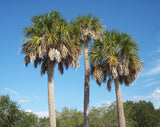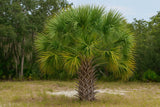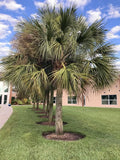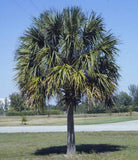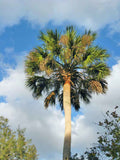Sabal Palmetto Seeds — The Cabbage Palm: Living Heritage in Every Kernel
Plant these seeds and you are planting more than a palm. You are planting a symbol of endurance, a coastal sentinel, a gracious host for wildlife, and a living piece of Southern culture.
🌿 Bloom, Appearance & Hardiness
-
Bloom color: Sabal palmetto produces creamy-white to creamy-tan flowers in large, branched inflorescences that often rise above the crown of fan-shaped leaves in late spring through summer. The blooms are fragrant, emitting a pleasant scent that draws pollinators.
-
Fruit: After flowering, shiny black (or dark) fruits (drupes/berries) develop in late summer into fall, providing food for wildlife.
-
Hardiness: This palm is hardy in USDA Zones 8B through 11. It tolerates chilling winters down to about 15°F (−9 to −10 °C) with some protection; in optimal climates it thrives in warm temperate and subtropical zones.
🐦 Wildlife & Ecological Role
-
The creamy flowers attract many bees, flies, wasps, beetles and other pollinators, not only for pollen but for nectar and fragrance.
-
The fruits are eaten by birds (including cedar waxwings) and by small mammals like raccoons; these animals help disperse seeds.
-
Sabal palmetto is a larval host for Monk Skipper (Asbolis capucinus) butterflies.
-
The dead fronds provide habitat (roosting/nesting) for wildlife: for example, yellow bats often shelter in the hanging dead fronds beneath the live canopy.
🌍 Cultural & Historical Significance
-
Known as the cabbage palm, palmetto, or cabbage palmetto, this tree has been integral in the life and lore of the Southeastern United States—used by Native American tribes (Seminole, Choctaw, Houma) for building materials (houses, drying racks, paddles, fish drags, arrows), for weaving, thatching, and tool making.
-
The “heart” or bud of the palm (also called heart of palm or swamp cabbage) is edible; harvesting it kills the tree, so in culture, it is treated as a precious resource.
-
Sabal palmetto is a symbol: the state tree of Florida, prominently featured on the flags or seals of Florida and South Carolina (The “Palmetto State”). Its tough, resilient form and ability to survive hurricanes, salt spray, drought, and variable soils make it a plant identity for coastal America.
🌱 Growing from Seed & Landscape Uses
-
Seed germination: Fresh seeds germinate more reliably. With warm soil and consistent moisture, germination may occur in a few weeks to a couple months. Keep them moist (but not waterlogged), warm, and lightly shaded until they establish.
-
Growth habit: Tall, robust, single-trunked palm with large costapalmate fan leaves. In young years, growth is slower; over decades the trunk thickens, crown spreads, and height can reach 40-60 ft (12-18 m) or more in favorable settings.
-
Soil & site: Highly adaptable: tolerates a range of soils (sandy, loam, clay), salt spray, brackish water, occasional flooding; prefers moist but well drained, full sun to part shade. Once established, drought-tolerant.
✨ Why These Seeds Are Special
Each seed carries with it:
-
The promise of creating a living symbol—a palm that weathers storms, decorates beaches, stands sentinel in tidal marshes, and lives through time.
-
A chance to foster habitat—for pollinators, birds, bats, and small mammals—which interact with this tree at many levels (flowers, fruit, dead fronds).
-
A link with human history: craft, survival, art, and identity in the Southeastern US. A tree that has been woven into myths, flags, foods, building traditions.
These Sabal palmetto seeds are not just botanical specimens; they are time-keepers, home-makers, and storytellers. Plant one, and let your landscape carry the legacy of palms that feel the salt in the wind, the pulse of hurricanes passed, and the awe of centuries.






